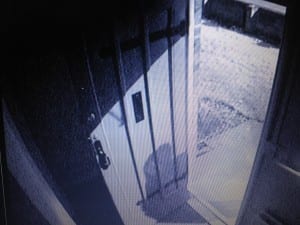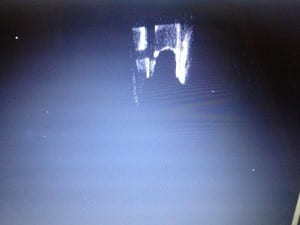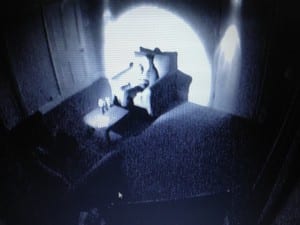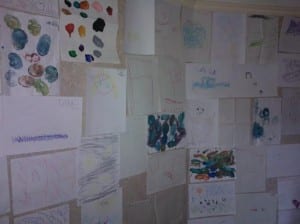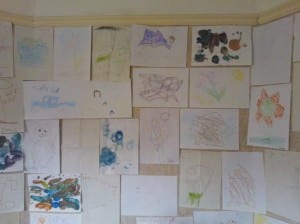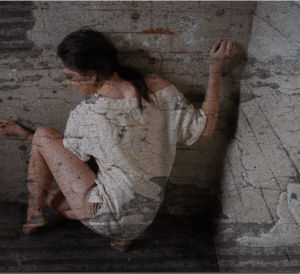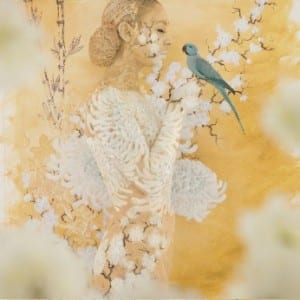Discussing Fiona Templeton in my previous Blog post and how the performance Recognition influenced the idea of us being in the house through Multimedia on alternate performance evenings, we decided to do this through creating an installation piece with us videoed in and around the house. This meant we only needed one of us for each performance evening (solving the Health and Safety issues) to set up and man the equipment, which worked to our advantage as we still got to see the audiences reactions to our work.
The Invisible Man is a story based around a character and how he refers to himself as The Invisible Man as people refuse to acknowledge his presence due to the fact he is black. We chose to expand on this idea of feeling invisible and apply it to the house, however given the obvious fact we were a group of females we took the theme and alternated it to a feminism. Through this we decided to do filming after dark with torches lighting up each room in the house and see what affects this would create. We chose have a soundscape over this for example someone making a cup of tea in the kitchen, a news reel in the living room, brushing of teeth when a torch is shone from those rooms making them rooms come alive with the sounds. As well as this another layer of sound with our voices reading extracts from The Invisible Man narrating the piece.
When filming the rooms within the house at night, each room spoke its own aesthetic narrative. The footage had a layer of fuzz creating a grainy affect over it due to the resolution in the dark. With this totally new visual in the dark we decided the narrative idea could be taken so much further that the soundscape and torches idea wasn’t as necessary and focused on the aesthetics of the piece. In this we will give the audience a pair of headphones with our voices relaying a narrative to them while they absorb the imagery on the TV screen, some will be existing texts that complement the visuals and others will be our own pieces of writing. We decided to take 3 shots each and watch them repeatedly and simply write what we saw and felt.
“You ache with the need to convince yourself that you do exist in the real world, that your part of all the sound and anguish” ((Ellison, Ralph (1965) The Invisible Man, Great Britain: Penguin Books Ltd.)) This is taken from The Invisible Man, with so in depth descriptions of personal emotion we decided to still incorporate this as it sparked the idea as a whole and with most the imagery showing a shadow,
Image by Lauren Hughes (2013)
silhouette
Image by Lauren Hughes (2013)
or distorted face
Image by Lauren Hughes (2013)
it linked in with that idea of having no identity, relating back to the title and also just giving that idea of feeling invisible and alone.
Safe house – definition; “a house in a secret location, used by spies or criminals in hiding” ((http://oxforddictionaries.com/definition/english/safe%2Bhouse?q=safe+house Accessed; 25/03/13)), or “a house where someone can hide or shelter” ((http://dictionary.cambridge.org/dictionary/british/safe-house?q=safe+house, Accessed; 25/03.13)). The fact that when people are taken to a safe house they have their identity taken all links in with our contribution to the final performance. Also with the definition including shelter we did filming in other people’s homes to see what their definition of a home was, whether it’s the place or people etc. which we were going to use within our piece before we came across The Invisible Man.
After recording the rooms at night we decided to have the CCTV room as the ‘room of screens’, with adding narratives to the videos, playing on a low volume when the audience enter filling the atmosphere with the ghostly whispers from the narratives. This project we decided to develop meant splitting the 1 minute clips of each room between us with 3 each sitting and watching these over and over…. And over again, we did this so the imagery could speak to us, even after watching one for 30 times unbelievably you would see something new or create a whole new narrative in your mind from these images. Giving that the three of us were female after reading the Invisible Man we chose to take the aspect of being invisible due to his ethnicity and use it through feminism and identity. Choosing to do so linked in really well with the Safe House which is all about identity.
Deciding to call the piece Safe House portrayed the essence of our piece as well as triggering ideas to enhance the feel of a Safe House, a safe homely feel, but also the authoritative aspects for example the agents, rules and regulations. “To start with, the dwelling space must give the impression of seclusion. If it is the task of the house to provide a refuge from the outside world, this must also find expression in the nature of the dwelling space” ((Bollnow, O.F (2011) “Human Space” London: Hyphen Press, p. 143)). A typical home for most of us is this way inclined and this is what the Safe House has… to a certain extent. The magic of our room being the last visited is for the audience to have explored the house knowing, but most likely forgetting for the majority of the piece that they are being watched, taking that idea of being secluded and keeping the private the private within a home is flipped on it’s head when they discover the CCTV screen.
When first hearing the term ‘Safe House’ I instantly envisaged films with characters being whisked away to a house in the country. However when researching into them it’s not all about the authorities keeping civilians safe, Safe Houses can be used to protect women who have been abused, foster children or hide illegal immigrants etc. When discovering the safe houses for women it linked in with our performance ideas, although our installation piece isn’t about being physically abused it still has that essence of oppression which is emphasised through the haunting atmosphere that fills the room when all the clips are playing in sync.
